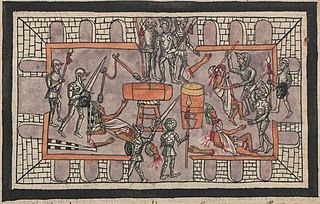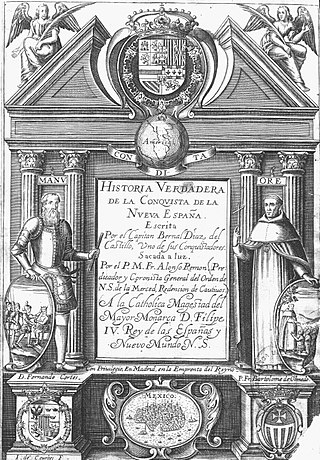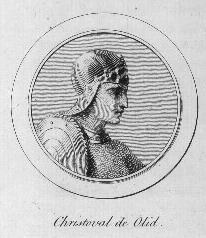
Hernán Cortés de Monroy y Pizarro Altamirano, 1st Marquess of the Valley of Oaxaca was a Spanish conquistador who led an expedition that caused the fall of the Aztec Empire and brought large portions of what is now mainland Mexico under the rule of the king of Castile in the early 16th century. Cortés was part of the generation of Spanish explorers and conquistadors who began the first phase of the Spanish colonization of the Americas.

Marina or Malintzin, more popularly known as La Malinche, a Nahua woman from the Mexican Gulf Coast, became known for contributing to the Spanish conquest of the Aztec Empire (1519–1521), by acting as an interpreter, advisor, and intermediary for the Spanish conquistador Hernán Cortés. She was one of 20 enslaved women given to the Spaniards in 1519 by the natives of Tabasco. Cortés chose her as a consort, and she later gave birth to his first son, Martín – one of the first Mestizos in New Spain.

Motecuhzoma Xocoyotzin, referred to retroactively in European sources as Moctezuma II, was the ninth Emperor of the Aztec Empire, reigning from 1502 or 1503 to 1520. Through his marriage with Queen Tlapalizquixochtzin of Ecatepec, one of his two wives, he was also king consort of that altepetl.

Tenochtitlan, also known as Mexico-Tenochtitlan, was a large Mexican altepetl in what is now the historic center of Mexico City. The exact date of the founding of the city is unclear, but the date 13 March 1325 was chosen in 1925 to celebrate the 600th anniversary of the city. The city was built on an island in what was then Lake Texcoco in the Valley of Mexico. The city was the capital of the expanding Aztec Empire in the 15th century until it was captured by the Tlaxcaltec and the Spanish in 1521.

Bernal Díaz del Castillo was a Spanish conquistador who participated as a soldier in the conquest of the Aztec Empire under Hernán Cortés and late in his life wrote an account of the events. As an experienced soldier of fortune, he had already participated in expeditions to Tierra Firme, Cuba, and to Yucatán before joining Cortés.

The Massacre in the Great Temple, also called the Alvarado Massacre, was an event on May 22, 1520, in the Aztec capital Tenochtitlan during the Spanish conquest of the Aztec Empire, in which the celebration of the Feast of Toxcatl ended in a massacre of Aztec elites. While Hernán Cortés was in Tenochtitlan, he heard about other Spaniards arriving on the coast – Pánfilo de Narváez had come from Cuba with orders to arrest him – and Cortés was forced to leave the city to fight them. During his absence, Moctezuma asked deputy governor Pedro de Alvarado for permission to celebrate Toxcatl (an Aztec festivity in honor of Tezcatlipoca, one of their main gods. After the festivities had started, Alvarado interrupted the celebration, killing all the warriors and noblemen who were celebrating inside the Great Temple.

Historia verdadera de la conquista de la Nueva España is a first-person narrative written in 1568 by military adventurer, conquistador, and colonist settler Bernal Díaz del Castillo (1492–1584), who served in three Mexican expeditions: those of Francisco Hernández de Córdoba (1517) to the Yucatán peninsula; the expedition of Juan de Grijalva (1518); and the expedition of Hernán Cortés (1519) in the Valley of Mexico. The history relates his participation in the conquest of the Aztec Empire.

Cristóbal de Olid was a Spanish adventurer, conquistador and rebel who played a part in the conquest of the Aztec Empire and present-day Honduras.

A tzompantli or skull rack was a type of wooden rack or palisade documented in several Mesoamerican civilizations, which was used for the public display of human skulls, typically those of war captives or other sacrificial victims. It is a scaffold-like construction of poles on which heads and skulls were placed after holes had been made in them. Many have been documented throughout Mesoamerica, and range from the Epiclassic through early Post-Classic. In 2015 archeologists announced the discovery of the Huey Tzompantli, with more than 650 skulls, in the archeological zone of the Templo Mayor in Mexico City.

The fall of Tenochtitlan, the capital of the Aztec Empire, was an important event in the Spanish conquest of the empire. It occurred in 1521 following extensive negotiations between local factions and Spanish conquistador Hernán Cortés. He was aided by La Malinche, his interpreter and companion, and by thousands of indigenous allies, especially Tlaxcaltec warriors.

La Noche Triste was an important event during the Spanish conquest of the Aztec Empire, wherein Hernán Cortés, his army of Spanish conquistadors, and their native allies were driven out of the Aztec capital, Tenochtitlan.

The Aztecs were a Pre-Columbian Mesoamerican people of central Mexico in the 14th, 15th, and 16th centuries. They called themselves Mēxihcah.

The Spanish conquest of the Aztec Empire was a pivotal event in the history of the Americas, marked by the collision of the Aztec Triple Alliance and the Spanish Empire, ultimately reshaping the course of human history. Taking place between 1519 and 1521, this event saw the Spanish conquistador Hernán Cortés, and his small army of soldiers and indigenous allies, overthrowing one of the most powerful empires in Mesoamerica.

Gonzalo de Sandoval was a Spanish conquistador in New Spain (Mexico) and briefly co-governor of the colony while Hernán Cortés was away from the capital.

Lorenzo Ferrero is an Italian composer, librettist, author, and book editor. He started composing at an early age and has written over a hundred compositions thus far, including twelve operas, three ballets, and numerous orchestral, chamber music, solo instrumental, and vocal works. His musical idiom is characterized by eclecticism, stylistic versatility, and a neo-tonal language.

The Battle of Otumba was fought between the Aztec and allied forces led by the Cihuacoatl Matlatzincátzin and those of Hernán Cortés made up of the Spanish conquerors and Tlaxcalan allies. It took place on July 7, 1520, in Temalcatitlán, a plain near Otumba during the development of the Conquest of the Aztec Empire. The result of the battle was a victory for the Spanish, which allowed Cortés to reorganize his army, having suffered casualties a few days before in the episode known as La Noche Triste. A year later, by reinforcing his army with new men and supplies, and creating alliances with the indigenous peoples who had been subjugated by the Aztec, Cortés managed to besiege and conquer Tenochtitlan.

Tlatelolco was a pre-Columbian altepetl, or city-state, in the Valley of Mexico. Its inhabitants, known as the Tlatelolca, were part of the Mexica, a Nahuatl-speaking people who arrived in what is now central Mexico in the 13th century. The Mexica settled on an island in Lake Texcoco and founded the altepetl of Mexico-Tenochtitlan on the southern portion of the island. In 1337, a group of dissident Mexica broke away from the Tenochca leadership in Tenochtitlan and founded Mexico-Tlatelolco on the northern portion of the island. Tenochtitlan was closely tied with its sister city, which was largely dependent on the market of Tlatelolco, the most important site of commerce in the area.

The massacre of Cholula was an attack carried out by the military forces of the Spanish conquistador Hernán Cortés on his way to the city of Mexico-Tenochtitlan in 1519. Francisco López de Gómara indicates that the massacre of Cholula began after Cortés captured and killed Cholulteca leaders, unleashing with this act the slaughter of 6000 people in less than two hours. According to his letters of relationship, Cortés affirms that he made this decision as a preventive action before a possible ambush by 20,000 Mexica soldiers. However, the accounts collected by Bernardino de Sahagún contradict this version since it is narrated that only unarmed Cholultec civilians were killed.

La Nueva España is a set of six symphonic poems by Lorenzo Ferrero written between 1990 and 1999, which is dedicated to the Spanish conquest of Mexico in 1519–21. The suite can be considered a kind of preparatory study to the opera La Conquista. This story—says the composer—is of great relevance and reminds us that cultural diversity is a precious asset that must not be squandered.
Xicomecoatl, Chicomácatl, or as he was referred to as by the Spanish conquistador Bernal Díaz del Castillo, "Cacique Gordo", was the ruler of the city of Cempoala while it was under control of the Mexica Empire.


















